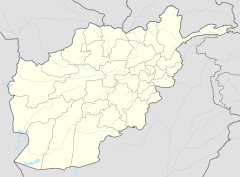| 1998 killing of Iranian diplomats in Afghanistan | |
|---|---|
| Part of the Battles of Mazar-i-Sharif | |
 | |
| Location | Mazar-i-Sharif, Afghanistan |
| Coordinates | 36°42′N 67°07′E / 36.700°N 67.117°E / 36.700; 67.117 |
| Date | 8 August 1998 (UTC+04:30) |
| Target | Iranian diplomats |
| Deaths | 11 (incl. one journalist) |
| Perpetrator | |
| Participant | |
| Motive | Iran's support for the anti-Taliban Northern Alliance during the Afghan Civil War |
On 8 August 1998, amidst the Battles of Mazar-i-Sharif, the Iranian consulate in Mazar-i-Sharif was attacked as the Taliban were besieging the city. Initially, only the deaths of eight Iranian diplomats was reported, but two other diplomats and a journalist were later confirmed dead as well, bringing the total casualty rate to 11 personnel. The executions of the diplomats are speculated to have been carried out by Sipah-e-Sahaba Pakistan. During this time, Iran was supporting the anti-Taliban Northern Alliance, and the killings heightened direct military tensions along the Afghanistan–Iran border, which was controlled on the Afghan side by the Taliban's Islamic Emirate at the time.
Background
Further information: Battles of Mazar-i-Sharif (1997–98)Before this incident, Iran was supportive of the Afghan Northern Alliance, and the city of Mazari Sharif was one of the headquarters of the alliance. It is reported that between May and July 1997 Abdul Malik Pahlawan executed thousands of Taliban prisoners as revenge for the 1995 death of Abdul Ali Mazari. "He is widely believed to have been responsible for the brutal massacre of up to 3,000 Taliban prisoners after inviting them into Mazar-i-Sharif." As revenge, Taliban forces captured Mazar-i-Sharif and killed hundreds of Northern Alliance members, particularly members of the Hazara and Uzbek ethnic groups as they were accused of being the ones who carried out the killings of Taliban prisoners.
Incident
On 8 August 1998, Taliban forces captured Mazar-i-Sharif. After this incident, 11 Iranian diplomats and Mahmoud Saremi, a correspondent from Iran's state news agency (IRNA), were attacked at the Iranian consulate and subsequently disappeared. Unofficial reports from the city indicated that all these men were killed. Later it was confirmed that 8 of the Iranian diplomats and Saremi were killed by the Taliban militia attacking the consulate. The Taliban spokesmen said the Iranians had been killed by renegade forces who had acted without orders. The final death toll was confirmed later to be 11 according to Tehran Times.
Aftermath

This incident caused a public furor in Iran and many observers were concerned that Iran would be involved in a military response to the attack. At the time, over 70,000 Iranian troops were deployed along the Afghan border. Mediation by the United Nations defused the situation and all the hostages were eventually released. Later in February 1999, the Taliban and Iran held talks, but relations between them did not improve. Subsequently, Iran decided to support the Northern Alliance, an anti-Taliban front.
August 8 is named National Journalists' Day in Iran, in memory of Mahmoud Saremi, the IRNA correspondent killed in this attack.
In popular culture
An Iranian film Mazar Sharif was made on this story in 2015. Abdolhassan Barzideh was the director.
See also
References
- ^ "Film on 1998 Iranian diplomats' murder in Mazar-i-Sharif premieres in Tehran". Tehran Times. 25 August 2015. Retrieved 7 August 2017.
- Riedel, Bruce (2010). The Search for Al Qaeda: Its Leadership, Ideology, and Future (2nd Revised ed.). Brookings Institution. pp. 66–67. ISBN 978-0-8157-0451-5.
- Gutman, Roy (2008). How We Missed the Story: Osama Bin Laden, the Taliban, and the Hijacking of Afghanistan. Institute of Peace Press. pp. 142. ISBN 978-1-60127-024-5.
- "Afghan powerbrokers: Who's who". BBC News. 19 November 2001. Retrieved 1 April 2011.
- Jehl, Douglas (11 September 1998). "Iran Holds Taliban Responsible for 9 Diplomats' Deaths". The New York Times. Retrieved 4 November 2008.
- Jehl, Douglas (12 September 1998). "For Death of Its Diplomats, Iran Vows Blood for Blood". The New York Times. Retrieved 4 November 2008.
- Session 53 The situation in Afghanistan and its implications for international peace and security S/1998/1109 page 2. 23 November 1998. Retrieved 2008-11-04.
- "Taliban, Iran hold talks". CNN. 3 February 1999. Retrieved 4 November 2008.
- "Why Iran is Concerned with Taliban 2.0". 5 October 2021.
- "Iran marks National Journalists' Day". Mehr News. 8 August 2014. Retrieved 6 August 2018.
- Mazar Sharif (2015), IMDB
- 1998 in Iran
- 1998 in Afghanistan
- Afghanistan–Iran relations
- Conflicts in 1998
- Diplomatic incidents
- Hostage taking in Afghanistan
- Iranian people murdered abroad
- Iranian terrorism victims
- People murdered in Afghanistan
- Terrorism deaths in Afghanistan
- Attacks on diplomatic missions of Iran
- Attacks on diplomatic missions in Afghanistan
- Afghan Civil War (1996–2001)
- August 1998 events in Afghanistan
- Massacres committed by the Taliban